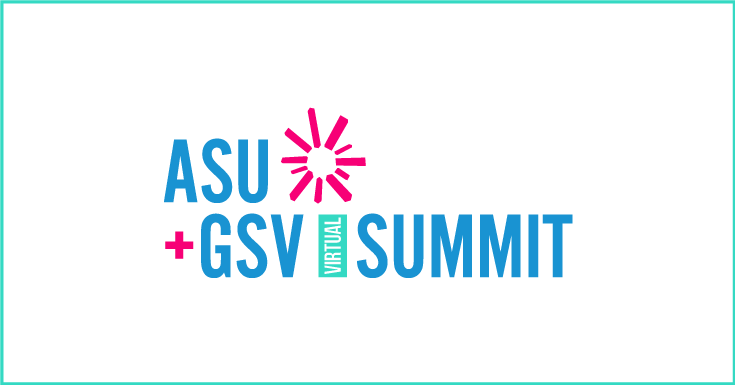From AI to DEI: Top Takeaways from ASU+GSV
Former Tambellini Analyst

If you haven’t attended the ASU+GSV Summit before, it is an experience not to be missed. A joint endeavor between Arizona State University (ASU) and Global Silicon Valley (GSV) Ventures, its “high tech meets education industry” focus brings thousands of innovative educators and EdTech entrepreneurs together each year to talk about “society’s greatest challenge: ensuring everyone has equal opportunity to participate in the future.”
ASU+GSV features networking sessions, pitch competitions, and an all-star lineup of speakers that rivals any Hollywood cast, and this year was no exception. Attendees heard keynotes from leaders such as General Colin Powell, Jon Meacham, Bill Nye, Gloria Steinem, and Charles Koch. Instead of meeting in person, this year’s ASU+GSV faced a little disruption of its own, when the coronavirus pandemic shut down most states and virtually all travel right about the time the conference was supposed to occur (March, in San Diego). Like any good entrepreneur, ASU+GSV pivoted, and this year’s event was a virtual summit held online over five days in late September and early October.
For education traditionalists, ASU+GSV may be a bit hard to take. Even some of the more innovative thinkers working to transform education from within the industry will roll their eyes at some of the hype. When I attended in person a couple of years ago, it reminded me a lot of my startup days, with many wide-eyed entrepreneurs convinced that we are only one good idea away from transforming the world or, in this case, education. The central thesis goes something like this: The education industry is too slow, too entrenched, and too unwilling to change, but external disruptors, entrepreneurial thinking, and EdTech innovations can provide a new way forward.
Titled “The Dawn of the Age of Digital Learning,” this year’s Summit certainly seemed to carry on this tradition of hype; digital learning isn’t exactly new, after all. But there was a significantly more nuanced picture painted in the keynotes, sessions, and conversations than what I’ve seen or heard in the past. There appeared to be a much deeper level of understanding of the complexities of education and a recognition that if we have any chance of solving the significant challenges we face, it will take a “both-and” approach and not “either-or.”
Here are some key themes that emerged for me at ASU+GSV this year.
Uptick in EdTech Investments
Over the past five years, US venture investment in educational technology (EdTech) has been largely flat monetarily, while the total number of deals has decreased. There has been a renewed interest in EdTech however, fueled by the pandemic and investors’ own experiences with remote learning and their children’s education through the pandemic. Investments are coming from firms who haven’t traditionally invested in EdTech, as well. This resurgence of investment could be both a boon and a burden for educational institutions, providing new solutions to vexing problems but additionally contributing to an already fragmented and costly technology ecosystem.
Promise (and Perils) of AI and ML
There was a myriad of sessions with titles like “AI Transforming Higher Learning” and “Can AI Robots Assess Human Skills?” Presenters were bullish on AI and machine learning (ML) and the promise that these technologies hold for everything from helping with language learning to improving student outcomes, overall. This in and of itself is not surprising, since the whole world seems to be talking about AI and many EdTech companies purport to use AI in some way. What is surprising is that, in comparison, there were far fewer sessions on augmented and virtual reality (AR/VR), although the growth of AR/VR in education is projected to be far greater than AI and ML. Also, pleasantly surprising was the inclusion of sessions focused on AI and ethics, and this statement from one presenter: “We should be terrified of the downside” of AI and its potential to accelerate inequities.
Education Across a Lifetime
From General Colin Powell’s reminder that education begins in the home to dozens of sessions focused on the education-to-employment pipeline, there was a clear message that we need to shift from thinking about education as a point-in-time activity—like a four-year degree—to a journey that lasts a lifetime. The best analogy I heard compared education to fitness: We don’t go to the gym for a fixed period of time and expect that we’ll be fit for the rest of our lives. Instead, we go every few days to maintain a level of fitness over our lifetime. The need for lifelong learning, degree pathways, alternative credentials, and upskilling and reskilling over the course of our careers and lives was a strong theme throughout the Summit.
Importance of DEI
Kudos to ASU+GSU for prominently highlighting the importance of diversity, equity, and inclusion (DEI) at the Summit. From broadly diverse sessions (I didn’t see a single manel!) to airing a Truth and Reconciliation Conversations documentary, there was a clear and present message that we must all face—head-on and with intention—deeply rooted issues of inequities and bias if we are to step into a “new era in which all people have equal access to the future,” the Summit’s tagline. Conversations focused directly on race, LGBTQ+, and the creation of more diverse and equitable workplaces, as well as on equity related to transfer systems, financial aid, and technologies like AI. It was uplifting to see the education and EdTech communities lean into these important conversations.
All in all, the ASU+GSV Virtual Summit was a thoroughly enjoyable and thought-provoking experience—one that left me hopeful and optimistic about the future of education.
Categories
Share Article:

Other Posts From this Author:
© Copyright 2025, The Tambellini Group. All Rights Reserved.